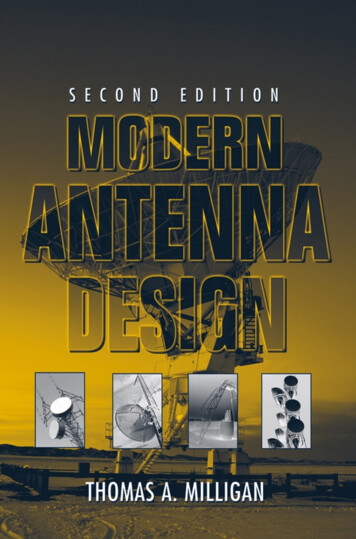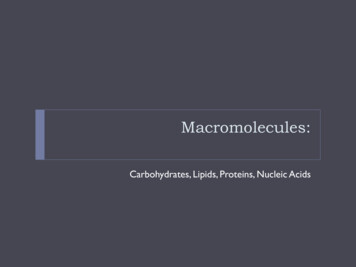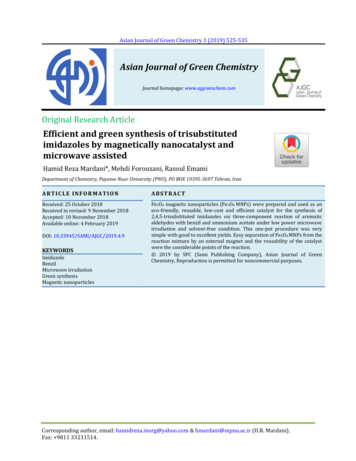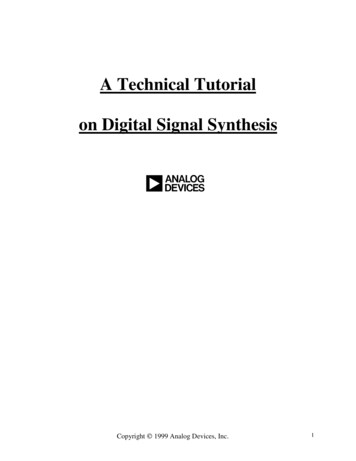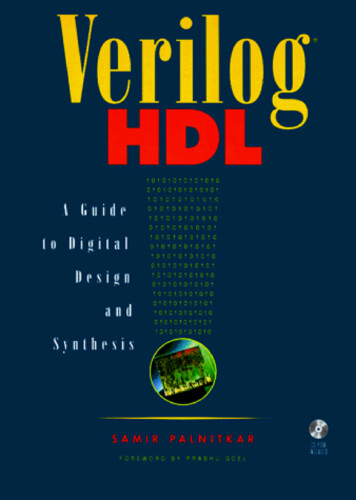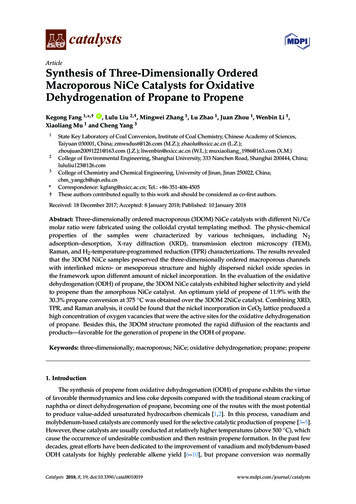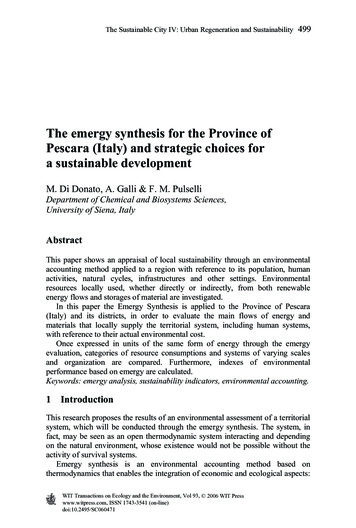
Transcription
The Sustainable City IV: Urban Regeneration and Sustainability499The emergy synthesis for the Province ofPescara (Italy) and strategic choices fora sustainable developmentM. Di Donato, A. Galli & F. M. PulselliDepartment of Chemical and Biosystems Sciences,University of Siena, ItalyAbstractThis paper shows an appraisal of local sustainability through an environmentalaccounting method applied to a region with reference to its population, humanactivities, natural cycles, infrastructures and other settings. Environmentalresources locally used, whether directly or indirectly, from both renewableenergy flows and storages of material are investigated.In this paper the Emergy Synthesis is applied to the Province of Pescara(Italy) and its districts, in order to evaluate the main flows of energy andmaterials that locally supply the territorial system, including human systems,with reference to their actual environmental cost.Once expressed in units of the same form of energy through the emergyevaluation, categories of resource consumptions and systems of varying scalesand organization are compared. Furthermore, indexes of environmentalperformance based on emergy are calculated.Keywords: emergy analysis, sustainability indicators, environmental accounting.1IntroductionThis research proposes the results of an environmental assessment of a territorialsystem, which will be conducted through the emergy synthesis. The system, infact, may be seen as an open thermodynamic system interacting and dependingon the natural environment, whose existence would not be possible without theactivity of survival systems.Emergy synthesis is an environmental accounting method based onthermodynamics that enables the integration of economic and ecological aspects:WIT Transactions on Ecology and the Environment, Vol 93, 2006 WIT Presswww.witpress.com, ISSN 1743-3541 (on-line)doi:10.2495/SC060471
500 The Sustainable City IV: Urban Regeneration and Sustainabilitythe final goal is to test the global behaviour of the system in relation to use andconsumption of natural resources.Statistical data from local and regional databases was used to monitor thematter and energy flows, as well as the main economic activities and incomesources.The use of emergy evaluation in a territorial system has the goal to provide anoverall view of the considered system and to evaluate (and quantify) itsenvironmental performance through sustainability indicators; this allows policymakers to make choices and adjustments in order to obtain the sustainability ofthe system or, at least, a better environmental performance.Hence, reading the results of this thermodynamic methodology, it is possibleto steer policy, focusing on local peculiarities and needs.An integrated evaluation of the main flows of natural and economicalresources that feed a region enables to understand how it is evolving towardssustainable pathways.Methods used for environmental analysis are characterized by a qualitativeapproach in determining the effects of human activities on ecosystems, whilenatural capital is underestimated, or even excluded, from conventional neoclassical economic assessments.For this reason, we need tools able to overcome classical approaches based onsingle criterions. Methodologies and indicators must offer the transition from areductionist to an holistic and ecological approach.This proposal also focuses on the principles of Ecological Economics, whichconsiders economy as an aspect of a whole ecological and social fabric, a livingsystem made of people interacting with each other and with the naturalenvironment.Ecological Economics faces the challenges imposed by the bio-physical lawsruling the planet and considers economic systems as open systems belonging to abroader ecological system. This approach implies the awareness of limits toeconomic growth.Economy is in fact constantly changing and evolving, depending on themutable ecological and social systems in which it is integrated.Odum's emergy synthesis is a methodology oriented to the holistic study ofsystems; it offers an integrated economic, ecological and thermodynamicevaluation of an environmental and/or productive system.The purpose of this methodology is the study, through an energetic andsystemic perspective, the organization of thermodynamically open systems, thatcan trade matter and energy with the external environment. The main goals are:assessment of the energetic externally forces applied to the system and whichdrive its evolution; evaluation of the role of natural resources in productioncycles; an evaluation of the work of the biosphere in the global dynamics ofanthropic systems; development of integrated economic environmentalaccounting; processing thermodynamic indicators of environmental yield, impactand sustainability.This work deals with the emergy analysis of Province of Pescara (CentralItaly).WIT Transactions on Ecology and the Environment, Vol 93, 2006 WIT Presswww.witpress.com, ISSN 1743-3541 (on-line)
The Sustainable City IV: Urban Regeneration and Sustainability501Much statistical data has been collected on the scale of six sub-areas (namelyCosta, Crinale Centrale, Vestina, Tremonti, Majella, Gransasso) so that thelocation of consumption, activities and land use, achieves a higher level ofaccuracy. Boundaries of sub-areas in the Province have been traced withreference to the Master Plan of the Province, in order to respect local economicand social dimensions and their characteristics. In this way, an appraisal ofsustainability may respond to any local area within the boundaries of theProvince.2 MethodologyThe concept of emergy is based on the assessment of all the natural resourcesthat have been used to provide a certain product or process. For this reason, thename emergy means energy memory and it works to give a measure of quantityand also quality of energy.Solar Emergy is the available solar energy used up directly and indirectly tomake a service or product and is measured in solar emjoules, abbreviated sej.Although this basic concept is quite straightforward, its implications arepotentially profound: H.T. Odum pioneered the development and use of emergyand presented it as a way of understanding the behaviour of self-organizedsystems. Emergy analysis considers all systems to be networks of energy flowsand determines the emergy value of systems involved.Since solar energy is the main energy input to the Earth, all other energies arescaled to solar equivalents to give common units. Other kinds of energy existingon the Earth can be derived from this main source, through energytransformations. Even the economy can be incorporated to this energy flownetwork since “wealth directly and indirectly comes from environmentalresources measured by emergy” (Odum [1]).An important concept in emergy analysis is Solar Transformity, defined as“the Solar Emergy required to make 1 J of a service or product” (Odum [1]).Solar Transformity is measured in sej/J. The Solar Transformity of a product isits Solar Emergy divided by its available energy. When an item is expressed inunits different than joules, for instance grams, the quality factor is emergy/mass(sej/g).From a practical point of view, transformity is useful as a convenient way ofdetermining the emergy of commonly used resources and commodities. Mostcase studies in the literature rely on the transformities calculated by Odum andco-workers to calculate the emergy of their inputs. Transformity is a possiblemeasure of the quality of energy and it is useful to compare different kinds ofenergy by using a common unit.Since the early 1980s, emergy analysis have been used widely to analyzesystems as diverse as ecological, industrial, economic; the analysis of fluxes bythe emergy methodology defines, in quantity and quality, the main exchanges ofenergy and matter, classifying these fluxes according to their origin anddestination.WIT Transactions on Ecology and the Environment, Vol 93, 2006 WIT Presswww.witpress.com, ISSN 1743-3541 (on-line)
502 The Sustainable City IV: Urban Regeneration and SustainabilityThe outcomes of the analysis will deal with the character of the territorialsystem revealing how many resources are locally available or otherwise importedby the outside.Furthermore, while fluxes are drawn in a diagram as kinds of vectorsidentified for their origin and direction, a second classification is made accordingto the renewability or non-renewability of their sources.The main steps of the emergy analysis of the Province of Pescara are:identification of the boundaries of the study area that correspond to theadministrative territory of the Province of Pescara; research of statistical datadealing with the anthropic activities taking place in the territory (productions,consumptions, inputs, outputs, market, etc.) and physical and geo-morphologicfeatures (solar energy, rain, soil erosion, mineral sinks, water, etc.). All datarefers to the year 2001; the calculation of matter and energy flows and theconversion of them into emergy by means of suitable transformities.Finally there is an overview on the total emergy flows supplying the system.Once the main inflows have been identified and the total emergy driving aprocess has been evaluated, a set of indices and ratios can be calculated. Theseindices are useful to study and compare processes under human control, where asustainable pattern is not guaranteed and choices have to be supported by carefulconsideration of many different parameters.Three main emergy flows can be recognized: renewable flows from within(R), non-renewable flows from within (N), and flows imported from outside thesystem (feedback flows, F), sometimes referred to as purchased flows. Thecharacteristics of emergy flows make it possible to calculate different indices formonitoring system’s behaviour.In this case study four indicators can be defined as follows. Theenvironmental loading ratio (ELR), is the ratio of purchased (F) and nonrenewable indigenous emergy (N) to renewable environmental emergy (R). It isan indicator of the pressure of the process on the local ecosystem and can beconsidered a measure of the ecosystem stress due to human activity.The emergy investment ratio (EIR) is the ratio of the emergy from outside (F)to the local emergy flows (R N). It shows if the process is a good user of theemergy that is invested, in comparison with alternatives. The empower density(ED) is the emergy per unit area. A high value of this index is found in areaswhere emergy is concentrated, such as cities and industrial sites. In such casesthe available area can become a limiting factor for development. This index isgenerally low in rural or undeveloped areas. In general, for equivalent processes,the higher the empower density, the higher the environmental stress.The emergy per person (EpP), given by the ratio of total emergy to thepopulation is an index of the standard of living which includes environmentaland economic contributions to the quality of life in terms of the availability ofresources and goods.3Results and discussionThe general framework of the Province is characterized by an area with miningindustry (Crinale Centrale) with high emergy flows and by an area (Costa) withWIT Transactions on Ecology and the Environment, Vol 93, 2006 WIT Presswww.witpress.com, ISSN 1743-3541 (on-line)
The Sustainable City IV: Urban Regeneration and Sustainability503high population density and relevant economic activities and high environmentalimpact.The results obtained for the Province give information about the resourcesexploitation in the territory according to their eMergy values.In general, the area is almost dependent on external inputs such as electricity,food items and other goods.Statistical data is then collected, along with detailed information on localproduction and consumption, imports and exports, and the economy, as well ason local geomorphology (solar irradiation, rain, soil erosion, ore deposits, water,etc.). Quantities and equivalent emergy values have been ordered into tables thatdistinguish different classes of resources.In Table 1, some inputs are quantified (in J/yr or g/yr) and equivalent amountsof emergy are gathered in groups as follows: local renewable R – local nonrenewable N – imported fuels and energy F1. In Table 2, the imports of goodsand services are quantified and the equivalent amounts of emergy are classifiedas F2. The transformities of each entry are reported on relative rows with thecorresponding reference: a (Odum et al. [2]), b (Tiezzi [3]), c (Bastianoni et al.[4]), d (Ulgiati et al. [5]), e (Bastianoni et al. [6]), f (Brown and Arding [7]), g(Tiezzi [8]), h (Ulgiati et al. [9]), i (Tiezzi [10]), j (Odum [11]), k (Odum andOdum [12]), l (Odum and Arding [13]), m (Odum and Odum [14]), n (Bjorklundet al. [15]), o (Odum [1]), p (Bastianoni et al. [16]). Values are in scientificformat (for example, 1.50E 2 means 1.50 x 102 that is equivalent to 150).Table 1:No.Emergy evaluation of indigenous resources (R, N) and importedfuels (F1) for the Province of Pescara, year 2001.ItemAmountUnit(unit/yr)Solar TransformityRef.Solar Emergy(sej/unit)(sej/yr)1Sunlight5.01E 18J / yr1.00E 00a5.01E 182Rain1.05E 15g / yr1.45E 05a1.52E 203Wind, kinetic energy5.71E 14J / yr2.47E 03a1.41E 184Waves1.03E 15J / yr5.10E 04a5.27E 195Tide3.39E 10J / yr7.39E 04a2.50E 156Geothermal heat1.76E 15J / yr3.02E 04a5.30E 197Soil erosion2.91E 14J / yr1.24E 05a3.61E 198Water, consumptions2.85E 13g / yr1.95E 06b5.55E 199Materials from mining5.10E 12g / yr1.68E 09a8.56E 2110Electricity useaimport1.30E 15J / yr2.07E 05p2.69E 20bthermoelectric3.51E 15J / yr2.07E 05p7.26E 20chydroelectric9.98E 13J / yr1.06E 05p1.06E 1911Gasoline and diesel7.79E 15J / yr1.11E 05o8.65E 2012Fuel oil, LPD and lubrificants1.63E 15J / yr9.30E 04c1.52E 2013Natural gas4.29E 15J / yr6.72E 04c2.88E 20RENEWABLE RESOURCES, R (sum of items 2, 5, 6 and 10 c)2.16E 20NON RENEWABLE LOCAL RESOURCES, N (sum of items 7, 8 and 9)8.66E 21IMPORTED RESOURCES (ENERGY and FUELS), F1 (sum of items 10 a, 10 b, 11, 12 and 13)2.30E 21A detailed analysis is given in Table 3; in this table, in particular, there is asummary of the main emergy flows and indices for the Province of Pescara andfor six districts (sub-areas).WIT Transactions on Ecology and the Environment, Vol 93, 2006 WIT Presswww.witpress.com, ISSN 1743-3541 (on-line)
504 The Sustainable City IV: Urban Regeneration and SustainabilityTable 2:No.Emergy evaluation of imported goods and materials (F2) forProvince of Pescara, year nit)Solar Emergy(sej/yr)AGRICULTURE1Cereals6.08E 12J / yr2.67E 05d1.62E 182Legumes3.37E 13J / yr1.39E 05e4.68E 183Fruits6.31E 12J / yr4.82E 05d3.04E 184Vegetables2.93E 11J / yr3.19E 06f9.36E 175Seeds7.49E 13J / yr1.33E 06d9.95E 196Spices and tabacco3.80E 12J / yr3.36E 05f1.28E 187Plants and flowers6.56E 08g / yr4.74E 09g3.11E 181.14E 20BREEDING, HUNTING and FISHING8Animals1.77E 14J / yr5.33E 06h9.44E 209Woods8.38E 09g / yr1.68E 08f1.41E 1810Hunting and fishing1.91E 09g / yr2.27E 08i4.34E 179.45E 20MINING INDUSTRY11Metal minerals1.81E 08g / yr5.81E 09h1.05E 1812Non metal minerals9.09E 10g / yr2.82E 09j2.56E 202.58E 20MANIFACTURING INDUSTRY13Food industryhuman1.39E 15J / yr5.33E 06h7.39E 21non human8.04E 13J / yr4.49E 05-3.61E 19beverages1.55E 10g / yr4.23E 09-6.56E 1914Tabacco industry-J / yr1.76E 05h-15Leather industry1.29E 12J / yr1.44E 07k1.87E 1916Textile industry3.91E 14J / yr6.38E 06f2.50E 2117Furniture and clothing industry3.99E 13J / yr6.38E 06f2.54E 2018Wood and cork industry3.47E 10J / yr5.86E 04l2.04E 1519Paper industry5.91E 15J / yr3.61E 05f2.14E 2120Graphic industy9.42E 11J / yr3.61E 05f3.40E 1721Metallurgic industry3.25E 10g / yr1.13E 10f3.66E 2022Mechanical industry2.12E 09g / yr2.10E 10m4.46E 1923Mineral industry1.04E 10g / yr3.09E 09n3.21E 1924Chemical industry2.64E 11g / yr6.38E 08o1.68E 2025Rubber industry3.53E 10g / yr7.22E 09f2.55E 2026Other manifacturing industries1.25E 10g / yr5.81E 09h7.28E 191.33E 22IMPORTED RESOURCES (GOODS and MATERIALS), F2 (sum of items 1-26)1.47E 22The total emergy use (U) for the Province of Pescara in 2001is 2.59E 22sej/yr that depends on the variety of activities and dynamics occurring within theareas. The total annual emergy use is a measure of wealth; several activities oftransformation industry, commerce, services, tourism, beside the density ofpeople, let the value increase.Locally available environmental inputs (R) account for about 0.9% of totalemergy supporting the Province of Pescara. Rain, tide, geothermal heat andhydroelectricity are included in the total renewable flow.In particular, a fraction of electricity use can be considered renewable,because it is produced inside the Province from hydroelectric plant (with aproduction of 27,000,000 kwh); thermoelectricity produced in the Province haveWIT Transactions on Ecology and the Environment, Vol 93, 2006 WIT Presswww.witpress.com, ISSN 1743-3541 (on-line)
The Sustainable City IV: Urban Regeneration and Sustainability505been considered non renewable and imported because fuel is not locallyavailable (Table 1).An additional contribution of 8.66E 21sej/yr comes from local nonrenewable flows. Extractive activity plays a significant role according to theemergy accounting of the Province (in particular for the area of CrinaleCentrale); the high amount of emergy contributed by extracted materials is dueto their quantities and, especially, to the high values of their transformities. Localresources, both renewable and non-renewable, represent about 35% of the totalemergy use in the area.The total imported emergy F is 10.70E 22 sej/yr, and is the sum of all thefluxes coming from the outside. It is about 66% of the total emergy used. Thisvalue is given by the sum of the emergy amount due to purchased energy andfuels F1 and purchased goods and materials F2.Table 3:Emergy evaluation and indexes for the Province of Pescara and itsareas, year 2001.AREAPROVINCE OF PESCARACOSTACRINALE CENTRALEGRAN SASSOMAJELLATREMONTIVESTINAFigure 1:Rsej/yr2.16E 202.55E 193.35E 193.19E 197.26E 191.75E 193.47E 19Nsej/yr8.66E 219.40E 204.38E 216.36E 182.29E 211.29E 209.20E 20Fsej/yr1.70E 227.67E 215.21E 218.20E 201.08E 215.73E 201.64E 21Usej/yr2.59E 227.50E 211.03E 227.04E 204.11E 216.58E 202.63E 21EDU / area2.11E 134.66E 134.76E 133.42E 121.35E 135.82E 121.17E 13EpPU / pop8.76E 163.99E 163.05E 177.89E 162.33E 174.28E 168.28E 16ELRN F / .951.1821.400.463.921.72Maps of emergy density and environmental loading ratio in theProvince of Pescara.This high percentage of resources coming from the outside means that there isa presence of many local entities that import resources from a huger context.WIT Transactions on Ecology and the Environment, Vol 93, 2006 WIT Presswww.witpress.com, ISSN 1743-3541 (on-line)
506 The Sustainable City IV: Urban Regeneration and SustainabilityOnce all the inputs have been classified into categories, some indicators arecalculated. Each area has been investigated, and the results of the analysis areshown in Table 3, that shows also a comparison between the Province of Pescaraand the six districts with different environmental and economic characteristics.Only a deep investigation of all the values, ratios and indicators, besides thefirst collection of data, allow to understand the real behaviour of each area andits role within the system. This outcome gives a clear vision of resourceconsumption throughout the area of the Province. Results are not homogeneousand show different conditions in different areas. Two districts (Crinale Centraleand Costa) have been highlighted as areas where very concentrated flows ofemergy are located, due to the population density and the presence of industrialactivities, high urbanization and resource use and extraction.The values of the emergy density (2.11E 13 sej/yr/m2) and the emergy perperson (8.76E 16 sej/yr/ab.) for the Province and for each district help toestimate respectively the pressure of the economic activity on the territory andthe standards of living in terms of availability of resources.The measure of spatial stress, represented by ED, is higher in Costa(4.66E 13 sej/yr/m2) and Crinale Centrale (4.76E 13 sej/yr/m2) than in theProvince of Pescara as a whole. Low levels are found in Gran Sasso (3.42E 12sej/yr/m2).The Emergy per Person (EpP) shows how consumption is related topopulation and, in a certain sense, this index represents the responsibility of eachinhabitant for the use of resources. The values for the Province of Pescara and itsdistricts Costa and Tremonti show a certain equilibrium between localconsumption and the presence of population; a high level of population density iscompensated by a moderate amount of resources per capita. The high value inCrinale Centrale derives from the existence of a relevant level of exploitation oflocal non-renewable resources.The Province of Pescara presents a high level of ELR, which reflect a largeruse of local non-renewable resources. This indicator achieves high values inareas such as Crinale Centrale and Costa. So, a large ratio suggests a high levelof environmental stress. Gran Sasso has lower values than other areas.The emergy investment (EIR) ratio is the ratio of the emergy feedback fromthe economy to the indigenous emergy inputs. A high level of the EIR in GranSasso represents a sort of fragility of the system because of its dependence oninputs from other economic systems and probably depends on tourism. InMajella there is a low level of purchased resources with respect to the localresource availability.4ConclusionsThe combined use of emergy synthesis, sustainable indicators, thermodynamics,is capable of providing synergic information on the dynamics of human systemsat any level. According to this information so provided, future strategic choiceshave to be directed in order to enhance the welfare of the local community andorient the consumption of resources. Environmental and landscape information,WIT Transactions on Ecology and the Environment, Vol 93, 2006 WIT Presswww.witpress.com, ISSN 1743-3541 (on-line)
The Sustainable City IV: Urban Regeneration and Sustainability507social information from statistical database can be fruitfully integrated within theconceptual framework of emergy synthesis, contributing to local policy making,as well as to understand the relation between local and “sub-local” economies.The real application of the eMergy analysis during the planning practicesconcerns practical choices even interacting with other actors, urban planners,stakeholders and policy makers.The best solutions are obviously the ones that decrease the value of theeMergy flows, that means decreasing consumptions of energy and matter withinthe local human settlement.The general results for the Province of Pescara suggest that compatibilitybetween some economic activities and increasing environmental protection ispossible, provided that the population density is relatively low and that localrenewable sources are used to a considerable extent. Sustainable economicactivities can provide economic support to the local population, thus preventingpeople from abandoning a territory for better living conditions. A better use ofenvironmental resources can maximize the total resource available and mayincrease economic vitality.References[1][2][3][4][5][6][7]Odum H.T., Environmental accounting: emergy and environmentaldecision making. Wiley, New York, US, 1996.Odum H.T., Brown M.T. & Williams S.B., Handbook of emergyevaluation: a compendium of data for emergy computation issued in aseries of folios. Folio #1 - Introduction and Global Budget. Center forEnvironmental Policy, University of Florida, Gainesville, FL, 2000.Tiezzi E. (Ed.), Implementazione di un sistema di contabilità ambientalesu scala provinciale e intercomunale. Experimental project sponsored byItalian Minister for the Environment. University of Siena and Province ofBologna, Bologna, Italy. 2001.Bastianoni S., Campbell D., Susani L. & Tiezzi E., The solar transformityof oil and petroleum natural gas. Ecological Modelling 186, 2005, 212220.Ulgiati S., Odum H.T. & Bastianoni S., Emergy analysis of Italianagricultural system: the role of energy quality and environmental inputs.(Eds.) Bonati L, Cosentino U, Lasagni M, Moro G, Pitea D ad SchiraldiA. Proc. 2nd Int. workshop - Trends in ecological physical chemistry.Elsevier, Amsterdam, The Netherlands, 1993, 187-215.Bastianoni S., Brown M.T., Marchettini N. & Ulgiati S., Assessing energyquality, process efficiency and environmental loading in biofuelsproduction from biomass. (Eds.) Chartier Ph, Beenackers A.A.C., andGrassi G. Proc. 8th European Biomass Conference - Biomass for energyenvironment, agriculture and industry. Pergamon, Oxford, 1994, 23002312.Brown M.T. & Arding J.E., Transformity Working Paper. Center forWetlands, University of Florida, Gainesville, FL, 1991.WIT Transactions on Ecology and the Environment, Vol 93, 2006 WIT Presswww.witpress.com, ISSN 1743-3541 (on-line)
508 The Sustainable City IV: Urban Regeneration and ezzi E. (Ed.), Analisi di sostenibilità ambientale del Comune di Pescia.Unpublished report, Siena, Italy, 2000.Ulgiati S., Odum H.T. & Bastianoni S., Emergy use, environmentalloading and sustainability. An emergy analysis of Italy. EcologicalModelling 73, 1994, 215-268.Tiezzi E. (Ed.), Studio per un progetto di valutazione di scenari per unosviluppo sostenibile della Laguna di Venezia, Unpublished report, Siena,Italy, 2000.Odum H.T., Emergy and Public Policy (Part I-II). EnvironmentalEngineering Sciences, University of Florida, Gainesville, FL, 1992.Odum H.T. & Odum E.C., Ecology and Economy. Emergy Analysis andPublic Policy in Texas. Lyndon B. Johnson School of Public Affairs,Policy Research Project Report n. 78. Austin, TX, 1987.Odum H.T. & Arding J.E., Emergy analysis of shrimp mariculture inEcuador. Department of Environmental Engineering Sciences, Universityof Florida, Working paper prepared for Coastal Resources Center,University of Rhode Island, Narragansett, RI, 1991.Odum H.T. & Odum E.C., Energy Analysis Overview of Nations. WP-8382, International Institute for Applied Systems Analysis, Laxenburg,Austria, 1983.Bjorklund J., Geber U. & Rydberg T., Emergy analysis of municipalwastewater treatment and generation of electricity by digestion of sewagesludge; a Swedish case study. Resources Conservation & Recycling 31(4), 2000, 293-316.Bastianoni S., Marchettini N., Principi I. & Tiezzi E., Sviluppo di unmodello di analisi emergetica per il sistema elettrico nazionale.Unpublished report, Siena, Italy, 2001.WIT Transactions on Ecology and the Environment, Vol 93, 2006 WIT Presswww.witpress.com, ISSN 1743-3541 (on-line)
sustainable pattern is not guaranteed and choices have to be supported by careful consideration of many different parameters. Three main emergy flows can be recognized: renewable flows from within (R), non-renewable flows from within (N), and flows imported from outside the system (feedback




